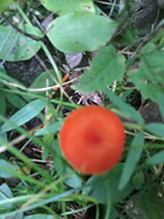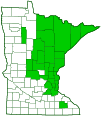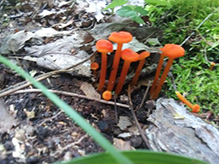Vermilion Waxcap
(Hygrocybe miniata)
Conservation • Description • Habitat • Ecology • Distribution • Taxonomy
|
|
||||||||||||||
Description |
Vermilion Waxcap is a small, brightly colored, gilled mushroom. It occurs in Europe, North America, Central America, and Australia. In the United States it occurs east of the Great Plains and in the Pacific Northwest. It is found from early summer to fall, in deciduous and mixed woodlands. It usually appears in groups but not clustered (gregarious), but it sometimes appears alone or scattered. It grows on the ground or on moss under hardwoods, especially oaks, and on rotting logs. The ecology is uncertain. The color is variable, changing as it ages, as it dries, and when it is remoistened. When it first appears, it is bright scarlet to reddish orange, the cap is convex, and the margins are curved inward. As it ages it flattens out and the color fades. Mature caps are convex or flat, often depressed or slightly depressed in the middle, and ⅜″ to 1 9⁄16″ (10 to 40 mm) in diameter. The margin is sometimes thinly lined (striate). The surface is dry and smooth or rough to the touch due to a covering of minute scales. When moist, it does not become sticky (viscid). As the cap dries, it fades first to orange and eventually to yellow, and it becomes more or less transparent (hygrophanous). When remoistened, it becomes opaque and more or less recovers its original color. The gills are broad and closely spaced to almost widely spaced. They are narrowly to broadly attached to the stalk, and they sometimes very slightly (“almost”) run down the stalk. They are the same color as the cap at first, and they fade to orange or yellow as the cap fades. Between the main gills there are one or more short gills that do not reach the stalk. The stalk is dry, hairless, ¾″ to 2 ⅜″ (20 to 60 mm) long, and 1⁄16″ to ¼″ (2 to 6 mm) thick, equal in size from top to bottom. It is colored mostly the same as the cap, but it is white at the bottom. The flesh is waxy, very thin, brittle, and orange to pale yellow, the same color as the cap or paler. It is edible but insubstantial. The spore print is white. |
Similar Species |
Habitat and Hosts |
Deciduous and mixed woodlands |
Ecology |
Season |
Early summer to fall |
Distribution |
||
|
Sources |
|
| 11/2/2024 | ||
Occurrence |
||
|
||
Taxonomy |
|
Kingdom |
Fungi (Fungi) |
Subkingdom |
Dikarya |
Phylum |
Basidiomycota (Basidiomycete Fungi) |
Subphylum |
Agaricomycotina (Higher Basidiomycetes) |
Class |
Agaricomycetes (Mushrooms, Bracket Fungi, Puffballs, and Allies) |
Subclass |
Agaricomycetidae |
Order |
|
Suborder |
Hygrophorineae |
Family |
Hygrophoraceae (waxcaps and allies) |
Subfamily |
Hygrocyboideae |
Tribe |
Hygrocybeae |
Genus |
Hygrocybe (waxcaps) |
Subgenus |
Hygrophorus |
Section |
Hygrocybe |
Subsection |
Hygrocybe |
Series |
Hygrocybe |
Subordinate Taxa |
|
|
|
Synonyms |
|
Agaricus coccineus ssp. miniatus Agaricus flammans Agaricus miniatus Hydrocybe constans Hydrocybe flammea Hygrocybe miniata Hygrocybe strangulata Hygrophorus congelatus Hygrophorus constans Hygrophorus flammans Hygrophorus flammezts Hygrophorus miniatus Hygrophorus strangulatus |
|
Common Names |
|
Miniature Waxy Cap Vermilion Waxcap Vermilion Waxycap Vermilion Waxgill |
|
Glossary
Gregarious
In mushrooms, growing close together but not clustered.
Hygrophanous
Referring to mushroom tissue that is dark and more or less transparent when moist, becoming paler and opaque as it dries out.
Saprobic
A term often used for saprotrophic fungi. Referring to fungi that obtain their nutrients from decayed organic matter.
Striate
Striped or grooved in parallel lines (striae).
Not Saprobic
Hygrocybe mushrooms were long thought to get their nutrients from dead or decaying organic matter (saprobic). This is now known to be untrue. However, the hosts and type of partnerships to those hosts remains unclear.
Visitor Photos |
||
Share your photo of this fungus. |
||
This button not working for you? |
||
Luciearl |
||
 |
||
MinnesotaSeasons.com Photos |
||
|
||
|
||

Slideshows |
|

Visitor Videos |
||
Share your video of this fungus. |
||
This button not working for you? |
||
|
Other Videos |
||
Hygrocybe miniata (Vermilion Waxcap) |
About
Apr 6, 2021 Found two Hygrocybe miniata (Vermilion Waxcap) under a cedar tree in a leisure park. They are not H.cantharellus (more decurrent gills) nor H.coccinea (bigger mushroom). |
Hygrocybe miniata, the vermilion waxcap, a small, bright red or red-orange mushroom |
About
Jul 4, 2023 Hygrocybe miniata, the vermilion waxcap, a small, bright red or red-orange mushroom Hygrocybe miniata, commonly known as the vermilion waxcap, is a small, bright red or red-orange mushroom of the waxcap genus Hygrocybe. It is a cosmopolitan species, that is found worldwide. In Europe, it is found in fields, on sandy heaths, or grassy commons in the autumn. It is found in rainforest and eucalypt forest as well as heathland in Australia. This channel is about knowledge. About the knowledge of nature (of the living world) and human nature (of consciousness). |

|
Created: 11/2/2024 Last Updated: © MinnesotaSeasons.com. All rights reserved. |




